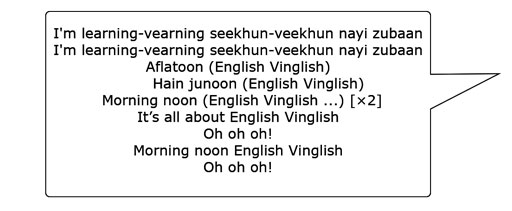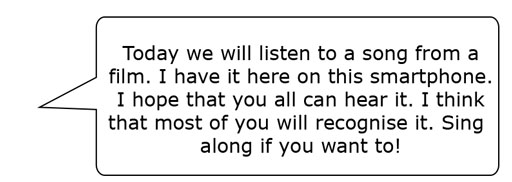3 Using songs
Many English songs are played on the radio. If you listen to popular songs in Hindi, Tamil, Telugu or any other Indian language, you will probably also hear lots of English words and phrases. Using songs that contain English words can be a good way to motivate your students to learn English and to help them practise English in an informal manner.
Songs in English can be used in listening activities, for learning new vocabulary, and for singing along and practising pronunciation. They can also be used as a prompt for a speaking or writing activity. Case Study 2 is about a teacher who uses a popular song in her English lessons. (See Resource 2 for the lyrics to the song she uses.)
Case Study 2: Mrs Rawool uses a local language song with English words in the classroom
Mrs Rawool is a teacher of secondary English. She uses a song with her students to increase their motivation and confidence to learn by bringing their attention to the English that they already use and hear around them.
Recently I noticed that a new song from the film English Vinglish is very popular among my students. I often hear them singing it when they finish their school day and are on the way home. I heard them singing:
I noticed that there were a lot of English words in the song, and that it was about learning English. I wanted to find out more about what the song was about, and whether I could use it in my teaching.
First I had to listen to the song properly. My colleague recently got a new smartphone. I asked if she could download the song. She told me that I could probably find the lyrics to the song too and I did (see Resource 2). I wrote them down during a teaching break. I asked my colleague if she would be kind enough to let me borrow her phone for my secondary English class the next day and she was happy to lend it to me.
That evening I was thinking about the song. Why did it make use of both Hindi and English? What do those ‘Hinglish’ words mean? What kind of activities could I do with the song in the classroom?
The next day, I told my students:
First I played part of the song. Once I started, I noticed big smiles across my students’ faces. I asked them if they could tell me what the song was. Nearly all of them recognised it and could tell me about the film English Vinglish, and how the housewife in it wants to learn English.
Then I told my students that I was going to play the song again and I asked them to write down the English words that they could hear. When they had finished, I asked them to compare their list with another student.
This was difficult because some of the words are in English, some are in Hindi and some are in ‘Hinglish’ or some made-up language. I played the song again and they checked again with a different student to see whether they had all the same words.
I asked them if they knew the meaning of all of the words in the song. The only one that they weren’t sure about was ‘bonding’. One student wanted to know if ‘Aflatoon’ was a real English word.
That was all I had planned to do with the song in that class, but my students were very motivated and interested to discuss it. The next day I decided to have a discussion about the use of English in India, based on ideas from the English Vinglish song and film.
Earlier I thought that using songs in my classes was just something fun. Now I realise that students can learn a lot from songs, and they have fun doing it.
Activity 3: Try in the classroom – using songs in the classroom
Like Mrs Rawool in Case Study 2, you can try using a song in your classroom. Use these steps to guide you:
- Choose a song with English that you can use with your classes. Choose something that will be familiar and interesting for students, and where the level of English isn’t too difficult.
- If possible, get an audio recording of the song (on a smartphone, MP3/4 player, or on a CD). You could download it from the internet or record it on a mobile phone. You could bring some inexpensive portable speakers or a CD player to class. (See the unit Helping your students to listen in Englishfor further advice on using audio in your classroom.) A copy of the song lyrics can also be useful – these can usually be found on CD jackets or on a website.
- Introduce the song to your students. Tell them to listen and write down the English words that they hear. After playing the song, have students compare their list of words with another student.
- Play the song again, and have the students compare their list of words with a different student.
- Ask your students if they have any questions about the words they have heard. Ask them to tell you what the song is about.
- Play the song one final time and tell students to sing along if they want to.
Pause for thought Here are some questions for you to think about after trying this activity. If possible, discuss these questions with a colleague.
|
Most students like music and will enjoy listening and singing along to songs in English or songs that have English words in them. You could ask your students to choose the next song that you discuss. They may have a particular song that they would like to understand better in English. You could try to translate the English words in songs into local languages, or to translate local songs into English. Other ideas for using songs in your classes are in Resource 3.
2 Using advertisements


